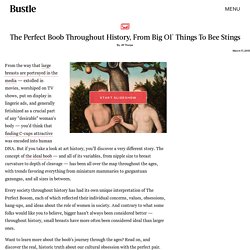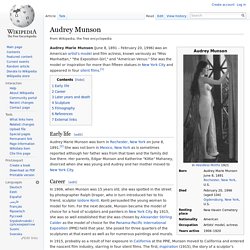

Photography of Women. The Perfect Boob Throughout History, From Big Ol' Things To Bee Stings. From the way that large breasts are portrayed in the media — extolled in movies, worshiped on TV shows, put on display in lingerie ads, and generally fetishized as a crucial part of any "desirable" woman's body — you'd think that finding C-cups attractive was encoded into human DNA.

But if you take a look at art history, you'll discover a very different story. The concept of the ideal boob — and all of its variables, from nipple size to breast curvature to depth of cleavage — has been all over the map throughout the ages, with trends favoring everything from miniature mammaries to gargantuan gazungas, and all sizes in between. Every society throughout history has had its own unique interpretation of The Perfect Bosom, each of which reflected their individual concerns, values, obsessions, hang-ups, and ideas about the role of women in society. Want to learn more about the boob's journey through the ages?
Want to learn more about the boob's journey through the ages? Gibson Girl. The Gibson Girl was the personification of the feminine ideal of physical attractiveness as portrayed by the pen-and-ink illustrations of artist Charles Dana Gibson during a 20-year period that spanned the late 19th and early 20th centuries in the United States.[1] The artist saw his creation as representing the composite of "thousands of American girls".

Image[edit] Gibson Girls at the beach "Woman: the Eternal Question" She was a member of upper middle class society, always perfectly dressed in the latest fashionable attire appropriate for the place and time of day. Fernanda Suarez "Tossing out blame" (2020) Gian Lorenzo Bernini "Blessed Ludovica Albertoni" (1674) Allan Gilbert "All is Vanity" (1900) Paul Delaroche "sketch of his wife Louise Vernet on her death bed" (1845) CAROTillustrations "Bun" (2016) Audrey Munson. Early life[edit] Career[edit] Munson returned to New York in 1919 and was living with her mother in a boarding house owned by Dr.

Walter Wilkins. Wilkins fell in love with Munson and murdered his wife, Julia, so he could be available for marriage.[1] Although Munson and her mother had left New York prior to the murder, the police still wished to question them, resulting in a nationwide hunt for them. They were finally questioned in Toronto, Canada, where they testified that they had moved out because Mrs. Later years and death[edit] By 1920, Munson, unable to find work anywhere, returned with her mother to the town of Mexico, New York and worked for a while selling kitchen utensils door to door.
In 1931, a judge ordered the 39-year-old Munson into a psychiatric facility for treatment. Fountain of the Setting Sun (1915) by Weinman Sculpture[edit] Priestess of Culture (1914) – PPIE, now in Fine Arts Museum of San Francisco Robert Ingersoll Aitken Karl Bitter Alexander Stirling Calder Isidore Konti. Jirka Väätäinen envisions Disney characters in "real life".
Robson Michel "Iara" (2018) "Weird Beauty" series by Alexander Khokhlov. Moscow-based photographer Alexander Khokhlov uses the human face as his canvas for creating graphic, black and white illustrations.

From the WiFi icon to the skip of a pulse line across his model's eyes, Khokhlov's vision is extraordinarily unique. Rather than relying on canvas, paper, or any other synthetic material as his foundation, Khokhlov relies on the beauty and lines of the feminine face to form this project, entitled Weird Beauty. The well designed face art, combined with simple and elegant female faces, presents viewers with a complex optical illusion of positive and negative space. Our eye is naturally and initially attracted to the strong black and white graphics painted by artist Valeriya Kutsan. But, after that, we are visually invited to explore the multiple layers of the photograph, from the swirls of perfect lines to the flawless skin, long lashes, piercing eyes, and emotionless expressions found beneath the paint.
Alexander Khokhlov's website via [PetaPixel] Disney Princesses reimagined historically by Claire Hummel.